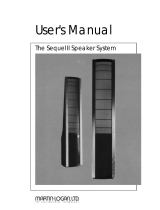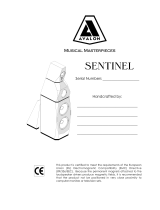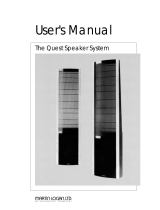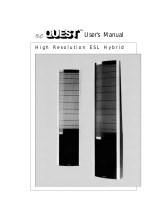
Item no.
69477
31.01

4
2
1

5
ab

6
3
Single wiring Bi- wiring

7
Type...............................................................D 870
System..................................3 Way Bassreflex
Woofer............................................6½ / 165 mm
Midrange.......................................6½ / 165 mm
Tweeter...............................................1 / 25 mm
Power handling*.......................150W / 200W
Frequency range...................30 - 22.000 Hz
Impedance................................................4 Ohm
Dimensions....................1035x278x381mm
40,7x10,9x15,0in
Weight.......................................32,5 kg / 71,7 lb
5
4
Specifications subject to technical changes.
*Long / Short term power, According to IEC 268-5.
6
www.jamospeakers.com

D 830 / D 870
Advanced Owners Manual

2
GB
Introduction
Congratulations on your choice of Jamo D 8. By choosing this high-end loudspeaker, you are ensured a very detailed natural sound
reproduction - that is, of course, if the rest of your system can match the loudspeakers. For you will also be able to mercilessly reveal any
possible shortcomings in the rest of the music chain as well as the music material used.
In order to get the maximum benefit it is therefore important to go through these instructions which offer good advice about installing/
connecting the units and about the acoustics of the listening room. We also tell you a little about the techniques we have used and the
decisions we have made to reach the goal - to present what it is all about - MUSIC!
A few comments on quality
To us at Jamo it is of fundamental importance that no Jamo loudspeaker is found to deviate from the reference model, irrespective of
production time.
In order to meet this requirement, all components and units must be approved within very narrow tolerances even at entry level. A
continuous quality control is performed on all semi-manufactures, and in the end all Jamo loudspeakers are put through a compulsory
final quality control before leaving the factory.
Jamos consistent high levels of quality and workmanship, and thus the uniform quality in production, are based on several factors,
notably the experience and expertise which have accumulated at Jamo since the companys start in 1968, as well as the fact that Jamo
was the first loudspeaker manufacturer in the world to obtain certification according to the strict ISO 9001 quality norm in 1992.
Unpacking
When you unpack your new loudspeakers, you might think that the glow of the cabinets and/or the colour play of the veneer do not
completely match the demonstration models that you may have seen at your Jamo dealers. However, this is just a result of the fact that
each piece of genuine veneer will have its own individual features, and since it is a natural material, you will find that the colour play and
the glow change as the loudspeakers are exposed to light and air. So in time they will look even better and have even more soul!
Remember also that loudspeakers should be broken in, that is play for some time, before they can perform at their best! If you do not
want to do this when you are at home, set your tuner between two stations, so that a hissing sound is heard from the loudspeakers. Then
leave the loud-speakers to play for a few hours at a medium sound level.
After this, the rest is up to you - we are sure that you will get many hours of fine entertainment.
Enjoy yourself!
Preben Jakobsen Julius Mortensen
The scope of the warranty
The warranty period will come into force as from the purchase
date stated on the invoice. The warranty will apply for the following
period of time:
2 years for electronics (power supply, amplifier, etc.)
7 years for other parts (cabinet, speaker units, etc.)
In case of warranty inquiries, please contact your dealer.
In case of request for service under warranty, please enclose your
original receipt.
Defects covered by the warranty:
Except for the defects stated below, the warranty covers any
production and material defects of the product.
Defects not covered by the warranty:
Defects arising from accidents, misuse, normal wear and tear,
mis-maintenance, voltage variation, overloading, stroke of
lightning, and other force majeure events
Defects arising from incorrect installation or operation
Defects arising from modification/repair/attempt of repair by a
non-authorised service centre
Defects arising from the use of non-original spare parts
Defects on products with altered or lacking series number
Other defects due to conditions or circumstances beyond the
suppliers control
Transportation costs for servicing are not covered by the warranty.
The supplier is liable only to repair or replace defective parts or
products. A replacement cannot exceed the value of the product
under warranty.

3
GB
Design Background
In the development of this loudspeaker series we have given a high priority to obtaining a neutral and natural sound balance, so that the
sound is reproduced with the exact same tonal characteristics as the original material. A natural benefit of this is that these loudspeakers
are able to reproduce all forms of music, speech etc. without adding any sort of colour to the sound.
Having started out with such an ambitious goal, an obvious requirement is to avoid any sort of compromise in the entire selection of
materials - from terminals to cables, drivers and cabinets.
In the actual developing phase we have therefore carried out listening tests of countless components before making the final selection.
We have also tested innumerable combinations of amplifiers, CD players and cables with all types of music and speech in order to ensure
construction of an entirely unique loudspeaker series to give you optimum performance in all circumstances.
Tweeter
The tweeter used was chosen because of its musical and ultra-precise reproduction capabilities.
This has been achieved partly by using a special SONOTEX diaphragm - the result of a process where the textile diaphragm is coated four
times to achieve the optimum combination of rigidity and internal dampening.
In order to prevent over pressure/under pressure from forming behind the diaphragm, this is vented through a hole in the magnet
leading into a carefully dampened chamber, mounted at the back of the unit. We have focused on obtaining a high sensitivity to allow
reproduction of the fine treble details, and therefore the voice coil is wound with silver thread and is controlled by a double magnet
system. Furthermore, the unit is equipped with low-viscosity magnetic oil, partly to ensure optimum cooling of the unit - and thereby a
high load capacity - and partly to dampen undesired resonances. The front baffle of the tweeter has been die-cast in solid zinc, which
ensures maximum mechanical contact with the cabinet and a minimum amount of undesired resonances. In addition, the tweeter area
on the front panel is slightly horn-shaped, resulting in a more linear reproduction of the lower treble to ensure optimum transition to the
midrange unit.
Woofer/Midrange Unit
In the D 8 series we wanted the important midrange area to be handled by a single unit, partly to achieve optimum phase characteristics.
However, this makes high demands on the unit used, as it must be able to reproduce a wide frequency spectrum and thus be able to
endure high loads.
The units diaphragm is made in die-cast magnesium - a very light and rigid material - and mounted in natural rubber suspension, which
effectively prevents vibrations from travelling back to the diaphragm. Therefore, the result is a very well-controlled diaphragm that will
operate without break-ups up to a full 4 kHz. Furthermore, the highly controlled break-ups can be completely eliminated in the crossover
network.
Waterfall plot showing the well-controlled diaphragm
break-up characteristics of the D 8 unit.
Waterfall plot showing the diaphragm break-up
characteristics of a good conventional woofer/midrange.
The heavy-duty magnet system has built-in copper rings which ensure significantly reduced distortion, as they will short out the eddy
currents which the voice coil will inevitably send into the magnet system when the signal current runs through it.
The units most eye-catching feature, however, is probably its backed-off copper phase plug. When a phase plug is used, it is no longer
necessary to mount a dust cap over the voice coil.
The advantage of this is that break-ups around the mounting point of the dust cap are avoided. As the phase plug is manufactured in solid
copper, it will also improve the efficiency of the copper rings and at the same time effectively remove heat from the magnet system.

4
GB
The units frame is manufactured in die-cast magnesium. Here the rigidity of the material is utilised to ensure that the heavy magnet
system and the voice coil remain in perfect position in relation to each other.
Furthermore, the magnesium frame ensures that the magnetic force stays concentrated in the magnet system instead of spreading out
into the basket.
Woofer, D 870
The keywords for choosing the woofer to be used in the D 870 were deep and transient. The woofers pressure die-cast magnesium
frame is therefore equipped with a powerful magnet system to control the travel of the long voice coil and the pressure die-cast PP
diaphragm, whose total mass is relatively large.
This careful combination of features results in an authoritative, pure and undistorted reproduction of even the deepest frequencies.
Crossover network
As described above, it has been of primary importance that the speaker units used should be of such
superior quality that they would have no shortcomings which would later have to be corrected for in
the crossover network.
Therefore, the crossover network in the D 8 Series is a relatively simple - in the most positive sense of
the word - low-order construction.
The advantage is that both the acoustic and the electrical phase angles are kept at very small values -
which of course is of great importance, both in terms of sound quality and amplifier load.
Another advantage is the high temperature stability achieved, meaning that the crossover frequencies
will always remain stable - even when the speakers heat up, which causes a change in their impedance.
The result is that the speaker units will always work within the intended frequency areas and that the
transition between the units remains perfectly stable in all circumstances.
Of course only components of the best quality have been employed in the crossover network: Foil
capacitors, wire-wound resistors and coils with a high Q factor. For the important midrange area, coils
with air cores are used to eliminate hysteresis errors.
The crossover network is mounted directly on the solid 24K gold-plated loudspeaker terminals to
ensure the shortest possible signal path and thereby prevent signal loss.
The internal wiring for connection to the woofer and midrange units is made with the newly developed
Jamo High Definition OFC (Oxygen Free Copper) Flat Cable with a sectional area of 2.5 mm2. This cable
features low resistance, no self-induction and low capacitive reactance, which means that it will not
affect the signal from the amplifier in any way, thus permitting full control over the units.
The advanced tweeter makes other demands on the cable. To ensure a natural reproduction of even the most delicate harmonics, it is
very important to have as low a capacitive reactance as possible. This has been achieved with another newly developed cable type, the
Jamo High Resolution Frequency Control OFC Flat Cable. This cable has a sectional area of 1.5 mm2 and large separation between the two
conductors.
Cabinet
Even the best units will never be able to provide optimum performance if a similarly serious approach has not been applied in manufac-
turing the cabinet. Therefore the units are mounted in Jamos world-patented NCC (Non Coloration Compound) material. The NCC front
is a sandwich construction consisting of two die-cast plastic shells which enclose a core consisting of a mix of quartz sand and a
resonance-dampening binding agent. One of the characteristics of the NCC material is that it is very heavy and extremely resonance-
dead. The efficient natural dampening means that when you listen to Jamo D 8, all you will hear is the sound of the units - there will be
no contribution or sound colouring from the front plate - not even when you play loud! Also, the sound cannot travel back and forth in
the baffle between the units.
The units are naturally countersunk in the front panel, just as all edges are rounded in order to reduce diffraction to a minimum - for the
same reason we have manufactured the front fabric panel in thin MDF board and made sure there is a very close contact between the
loudspeaker and the fabric panel.

5
GB
The cabinet itself is manufactured in 25 mm veneered MDF board which in addition is braced internally and carefully dampened with
acoustic absorption foam. The surface of the foam has been furnished with a honeycomb pattern to give it the largest possible surface
area and hence maximise dampening of the sound emitted from the rear of the unit.
Installation
Placing
Placing speakers in a listening room is always a very critical operation, and therefore we have provided a few guidelines below, but we
also recommend that you experiment with the placing until you think the sound reproduction is perfect.
In general, placing a loudspeaker near a rear and/or side wall will boost the low frequency level but at the same time create reflections
in the midrange and treble area, which results in a deterioration of the stereo perspective.
Therefore, it is not possible to recommend one perfect placing in relation to the rear wall, as the optimum distance will depend very
much on the acoustics of the listening room. As a guideline for placing D 830, the optimum placing will be about 30-60 cm / 12 - 25 in.
from the rear wall, and for D 870 it will be about 50-100 cm / 20 - 40 in.
For both models, the distance to the side walls should be at least 1 m / 40 in.
In order to achieve optimum sound reproduction, the distance between the loudspeakers should be the same as the distance from either
loudspeaker to your preferred listening position (an equilateral triangle).
The loudspeakers might be angled slightly toward the listening position, to adjust the treble level to suit the room acoustics and your
taste. This will also ensure that the optimum listening position becomes less critical.
There should be no furniture or other obstacles between the speakers and the listening position.
NOTE: If you are also using the D 8 loudspeakers in a surround sound configuration, the loudspeakers may be placed as near as approx.
15 cm / 6 in. from the television set without any discoloration of the picture.
Recommended placing of D 870 Recommended placing of D 830
Also, D 830 should be placed at the proper listening height. For
this specific purpose we have manufactured Stand 60. Using this
stand will ensure that the loudspeakers are placed at the optimum
listening height.

6
GB
Connecting
Jamo D 8 is equipped with gold-plated terminals which will accept heavy stripped cables. Your local Jamo dealer can advise you on
which cables to buy. In general, the longer the cable, the higher quality should be used to avoid signal loss in the cable itself. In terms of
sound quality it is therefore an advantage not to use cables which are longer than required, although the cables used to connect each of
the speakers should be roughly the same length.
Single wiring
If you wish to use cables with stripped ends, proceed as follows
1. Turn off the amplifier.
2. Gently strip off approximately 15 mm of the insulation on
the cable ends - be careful not to damage the cable wires.
3. Twist the wires.
4. Turn the terminal screws counterclockwise until the twisted
wires can easily be inserted into the holes.
5. Turn the terminal screws clockwise to secure the cables in
the terminals.
NOTE:
Verify that the wires from the + and - cables do not touch
each other, as a short-circuit could damage the amplifiers
output stage.
Spikes
We recommend that you use the enclosed spikes (option supplied with D 870 + Stand 60). These ensure stability of the loudspeaker with
good mechanical contact to the surface, irrespective of the surface material used.
Always check that all spikes are adjusted so that the
loudspeaker sits without rocking, before the lock nuts are
tightened.
On hard surfaces (for instance wood or stone), D 870 can
be placed on the integrated console feet. If you use D 830
with Stand 60, the supplied rubber feet can be used to
protect the floor against the pointed spikes.
Note:
Never drag or push the loudspeaker across the floor after
mounting the spikes, as this will damage carpeting and
floorboards.
If you wish to connect each speaker with a single cable, the
supplied bridges should remain fitted between the two
sets of terminals.
The loudspeaker comes from Jamo with the bridges fitted
for single-wiring.
Single wiring, D 830
Single wiring, D 870
2
1

7
GB
Bi-wiring
If you are using bi-wiring, remove the bridges between
the two sets of terminals.
You can connect the cables together to one set of output
terminals on the amplifier, or, if the amplifier has two sets
of output terminals, connect one cable to terminal set A
and the other cable to terminal set B.
Bi-wiring, D 830
Bi-wiring, D 870
Bi-amping
In bi-amping the loudspeakers are connected to two power amplifiers.
Here you have two options:
1. Connect amplifier 1 to the tweeter/midrange.
Connect amplifier 2 to the woofer.
(When different amplifiers are used).
- or -
2. The two amplifiers are used for the left and right channels, respectively, i.e. the tweeter/midrange units are connected to one
channel on the amplifier, and the woofer is connected to the other. (Typically when identical amplifiers are used)
Consult your Jamo dealer for further information.
Always make sure that the loudspeakers are in proper phase;
The + terminal on the loudspeaker is connected to the + terminal on the amplifier.
The - terminal on the loudspeaker is connected to the - terminal on the amplifier.
Loudspeaker cable is usually marked on one cord; this cord is normally used to connect the + terminals, this way it is easy to ensure that
the loudspeakers are in correct phase.
2
1

8
Treble adjustment
D 870 is equipped with an extra set of terminals for fine-tuning the treble level to your listening room characteristics and your personal taste.
On the following illustrations you can see the different possibilities.
Single wiring Bi-wiring Resulting
treble reproduction
The Acoustics of the Listening Room
Reverberation
The reverberation time of a room is the time it takes before a given sound impulse has died out. You have probably tried to clap your
hands in an empty room and heard how long it takes for the echo to disappear (long reverberation time), and then tried it after installing
furniture, etc., and found that now the echo is significantly shorter (short reverberation time).
It is obvious that a loudspeaker will sound different in these two rooms.
Therefore, in the development of loudspeakers, other than special measurement rooms, Jamo also uses a room that complies with the
IEC norm 268-13, which, briefly stated, recommends a reverberation time of 0.4 of a second for the frequency area between 250-4000
Hz and 0.8 of a second for the area below 250 Hz.
Of course it is very difficult to determine if your living room at home has exactly the right reverberation time, but by using the hand clap
test in different rooms, you can easily get an impression of whether or not your listening room is well dampened.
Obviously, your listening room must suit your personal music and taste, but if you think the acoustic character of the room is too hard
(which is the typical problem), you can find some solutions to this problem in the following section.
GB

9
Reflections and dampening
The worst reflections are the so-called flutter echoes - that is sound which is thrown back and forth between two parallel surfaces and
thus gives a very long reverberation time. In the ideal listening room the walls would therefore be angled just a little in relation to each
other.
However, you can obtain a similar effect in a number of ways:
1. By placing for instance a painting at a slight angle in relation to the wall.
2. By hanging up curtains.
3. By hanging up/moving wall carpets or the like.
4. By placing/moving bookcases or the like.
It is of course of great importance where objects such as the above are placed in the listening room, but again you can use the hand clap
test to help you find the major problem areas in the room.
Dampening the wall behind the loudspeakers is usually not particularly critical, whereas the side walls and the walls behind the listening
position should generally be sound-absorbing.
From a subjective point of view, reflections from the floor and ceiling are usually the most disturbing ones. It can be difficult to do much
about reflections from the ceiling without affecting the aesthetics of the room, whereas it is easier to reduce reflections from the floor:
1. Physically small loudspeakers should be placed on stands (partly to obtain the right listening height, and partly to move the woofer
away from the floor).
2. Place a thick carpet between the loudspeakers and the listening position.
Generally, the room will be more anechoic the more absorption material you use, but it is important that the material is placed correctly
in order to obtain the best possible result.
The result will often be a compromise between the interior design and the optimum placing of the loudspeakers, but as you can see
already, by taking a little time you can easily improve the acoustics of your listening room without running into excessive costs.
Maintenance
GB
All Jamo loudspeakers are manufactured in modern and
thoroughly tested materials, which normally do not require
any maintenance other than vacuum cleaning or using a
soft, dry cloth to remove dirt.
If the loudspeakers have become greasy, you can clean
them by moistening the cloth with water or perhaps using
a mild detergent.
Note:
Never use scouring powder, petrol, ethyl alcohol or solvents
to clean the loudspeakers.
-
 1
1
-
 2
2
-
 3
3
-
 4
4
-
 5
5
-
 6
6
-
 7
7
-
 8
8
-
 9
9
-
 10
10
-
 11
11
-
 12
12
-
 13
13
-
 14
14
Jamo D 830 Owner's manual
- Type
- Owner's manual
- This manual is also suitable for
Ask a question and I''ll find the answer in the document
Finding information in a document is now easier with AI
Related papers
Other documents
-
JBL 1X/1Xtreme/One User manual
-
Harman Kardon festival 80 Troubleshooting/Repair Tips
-
Snell Acoustics Snell Illusion A7 Owner's manual
-
XTZ 99.36 FLR Owner's manual
-
 MartinLogan Sequel II User manual
MartinLogan Sequel II User manual
-
Dynaudio Evidence Platinum Owner's manual
-
 Avalon Acoustics Sentinel User manual
Avalon Acoustics Sentinel User manual
-
 MartinLogan Quest User manual
MartinLogan Quest User manual
-
 MartinLogan reQuest User manual
MartinLogan reQuest User manual
-
 MartinLogan Aerius User manual
MartinLogan Aerius User manual


















